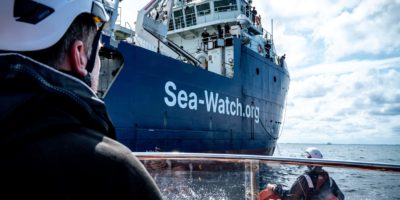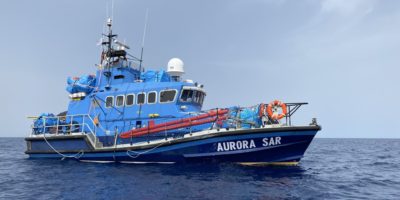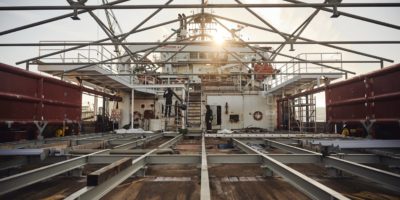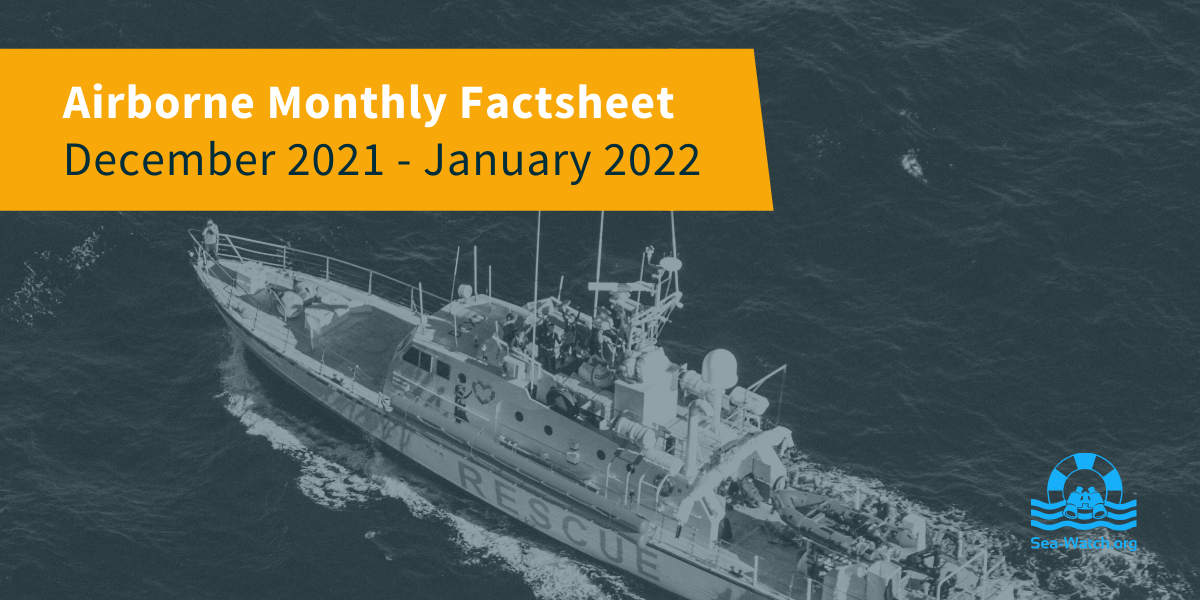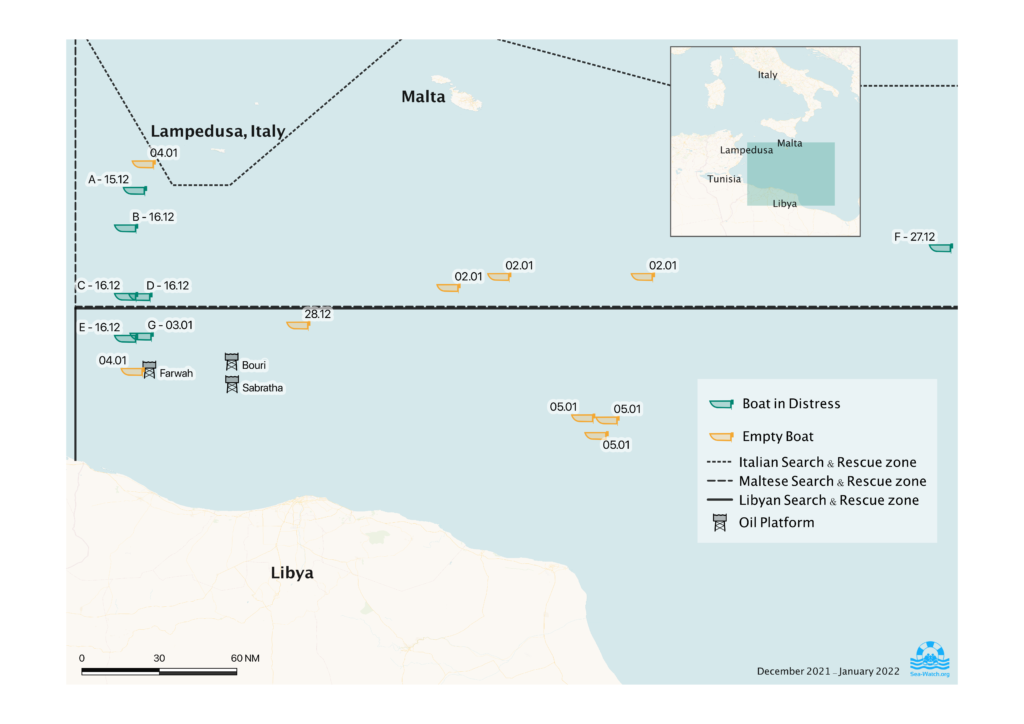This factsheet outlines a summary of the distress cases witnessed in December 2021 and January 2022 by Sea-Watch’s Airborne crews with their aircraft Seabird*. Sea-Watch also conducted test-flights during this time with the aircraft Skybird**. In December 2021 and January 2022 we conducted 11 operations, with a total flight time of 63 hours and 15 minutes. We spotted at least 388 persons in distress aboard 7 different boats.
Overview of boats in distress and empty boats spotted
Maltese Search-and-Rescue (SAR) zone
- 1 boat in distress, with around 15 people, was rescued by the Italian authorities or arrived independently in Lampedusa, Italy
- 2 boats in distress, 126 persons, were rescued by the NGO vessel Sea-Eye 4*** and disembarked in Pozzallo, Italy
- 1 boat in distress, 17 persons, was rescued by the merchant vessel Pan Unity and transshipped to a patrol boat belonging to the Armed Forces of Malta
- The outcome for 1 boat in distress, with at least 70 persons, remains unknown
- Estimated number of persons in distress: 228
Libyan Search-and-Rescue (SAR) zone
- 1 boat in distress, around 60 persons, was intercepted by the so-called Libyan Coast Guard and pulled back to Libya
- 1 boat in distress, around 100 persons, was partly transferred to the Tunisian Navy and pushed back to Tunisia after the people on board had found temporary refuge on the gas platform Miskar. 31 other persons were rescued by the NGO vessel Louise Michel***** and disembarked in Lampedusa, Italy
Estimated**** number of persons in distress: 160
Details and outcomes of selected boats in distress and empty boats
On December 16th, Skybird’s crew spotted 4 boats in distress, carrying around 256 persons. The people from 2 boats were rescued by the NGO vessel Sea-Eye 4 and disembarked on December 24th in Pozzallo, Italy. One boat was intercepted by the so-called Libyan Coast Guard and pulled back to Libya. The outcome for the other boat remains unknown. Skybird’s crew also spotted an ongoing interception by the so-called Libyan Coast Guard, where the people concerned were pulled back to Libya.
16.12., distress case B, around 70 persons: Non-assistance, fishing vessel seemingly standing-by, Maltese authorities refusing to cooperate, unknown outcome. The people in distress were spotted adrift in the Maltese Search-and-Rescue (SAR) zone in the morning. The Maltese authorities were informed via email. Skybird’s crew spotted the boat again at noon. One unidentified fishing vessel which could not be reached via radio was 1 nautical mile (nm)****** away from the people, seemingly standing-by. Another fishing vessel was also observed approaching the scene. The Maltese Rescue Coordination Centre (RCC) was called regarding the case at the end of the afternoon. The operator informed Airborne’s ground crew that the RCC was “very busy” and that it would respond via email – this never happened. At one point the officer also hung up on Airborne’s ground crew. Over the morning of December 17th, the Maltese authorities hung up twice on Airborne’s ground crew and for a third call they were unreachable. The Italian Maritime Rescue Coordination Centre (MRCC), when called referred to the Maltese authorities and hung up. The outcome for this case is unknown.
16.12., distress cases C and D, 126 persons: Successful rescue operation by NGO vessel with the support of civil actors, civil society again fills the gap left by European Member States in the Central Mediterranean Sea. For the second case, the initiative Watch the Med – Alarm Phone was called by the people in distress and informed the authorities and Airborne. Skybird’s crew spotted both boats in distress in the Maltese SAR zone. Due to a lack of European rescue assets in the Central Mediterranean, the NGO vessel Sea-Eye 4 changed course towards the people and rescued them. The people were disembarked in Pozzallo, Italy, on December 24th.
16.12., distress case E, around 60 persons: The so-called Libyan Coast Guard pursuing people in distress, interception and pullback to Libya*******. When Skybird’s crew arrived on-scene, the so-called Libyan Coast Guard was chasing the people in distress. The Libyan patrol boat was manoeuvring in an extremely dangerous manner, putting the persons on board at acute risk. The incident lasted around one hour. At one point, the engine of the people in distress stopped. The so-called Libyan Coast Guard intercepted the people and pulled them back to Libya.
27.12., distress case F, 17 persons: Persons left alone at sea for several days, non-assistance by authorities, rescue by a merchant vessel with the support of civil society. During the early morning of the December 26th, the initiative Watch The Med – Alarm Phone was called by around 30 persons on board a boat in distress, whereupon the initiative informed the authorities, updating them over the course of the next days. On December 27th, Seabird’s crew spotted the boat in distress in the Maltese SAR zone and informed the authorities again, as well as merchant vessels in the vicinity. The merchant ship Pan Unity, flying the flag of Panama, acknowledged the distress call and took the people on board in the late afternoon of December 27th. Later, the merchant vessel approached Malta and transshipped the persons to a vessel belonging to the Armed Forces of Malta. The 17 persons were safely disembarked in Malta on the afternoon of December 28th – over 60 hours after the first alert to authorities by the Initiative Watch The Med – Alarm Phone.
03.01., distress case G, around 100 persons: Unresponsiveness of offshore platforms and a merchant vessel in the vicinity of a distress case, people found refuge on a gas platform in the Maltese SAR zone, were partly pushed back by the Tunisian Navy to Tunisia, partly rescued by a civil actor. On the afternoon of January 3rd, Seabird’s crew spotted a double-decked wooden boat carrying around 100 persons without lifevests and informed the authorities********. The aircrew tried to contact three different offshore platforms in the vicinity – all without success. The merchant vessel Maridive 601, flying the flag of Belize, and its respective company were also unresponsive at first. Later however, the company as well as the insurance company of the vessel answered the calls. Still, the merchant vessel did not launch a rescue operation. The civil rescue ship Louise Michel answered the distress call, and changed course towards the position of the boat. When the Louise Michel arrived on scene, some of the people were on the Miskar gas field platform, which is owned by the company Shell and flies the Tunisian flag. The civil rescue vessel was able to take 31 people on board from the still drifting wooden boat. Even though the platform lies in the Maltese SAR zone, Miskar refused to communicate with the Maltese authorities and ultimately allowed the Tunisian Navy to take the remaining people from the platform and push them back to Tunisia, on January 4th. The NGO aircraft Colibri 2 was also on-scene and documented the transferral of the people*********. International Maritime Law requires that a rescue only ends with a disembarkation in a place of safety. Tunisia disqualifies as such: it does not have a national asylum system, people on the move are arbitrarily detained and certain groups, such as LGBTQI+ persons, are criminalized and persecuted. The 31 persons rescued by the Louise Michel were disembarked in Lampedusa, Italy, on January 5th.
Airborne’s ground crew monitored Frontex through open sources and found that on the morning of January 4th, Frontex’s aircraft Osprey2 was orbiting in a position which matched with the case. We must then assume that Frontex was involved in the pushback to Tunisia.
On January 22nd a similar incident occurred, when the NGO vessel Geo Barents********** was searching for a boat in distress and later learned that the people had first landed on the Miskar platform and were later intercepted by the Tunisian Navy and pushed back to Tunisia***********.
06.01., NAVTEX************ shared by RCC Malta about a boat, unsuccessful search by Seabird’s crew. On the afternoon of January 6th, RCC Malta sent out a Navtex about a boat carrying two persons, which had departed from Tunisia, and requested all vessels “to keep a sharp lookout and report any sighting”. Seabird’s crew searched the area of the given position but was not able to find anything. The outcome for this case is unknown.
In December 2021 and January 2022, Frontex was involved in at least 1 case.
Over December 2021 and January 2022, Seabird und Skybird’s crews spotted 9 empty boats. Only one of these could be matched with a known rescue operation which was conducted by the NGO vessel Geo Barents.
These missions highlight once again:
- the deadly consequences of European migration and border policies
- the systematic non-assistance by European Member States and their delegation of rescue operations to the so-called Libyan Coast Guard
- dangerous operational manœuvres used by the so-called Libyan Coast Guard, which expose people in distress to acute dangers at sea
- the current non-assistance of merchant vessels and their involvement in interceptions due to a failed politics of migration in Europe
- the unjustified and systematic delays by European Member States to fulfil their obligations to conduct and coordinate sea rescue in their Search-and-Rescue zones
- the need for NGO vessels in the Central Mediterranean Sea in order to uphold the law and save human lives
*Since 2017, together with the Swiss NGO Humanitarian Pilots Initiative, Sea-Watch monitors the Central Mediterranean with its aircraft Moonbird and Seabird.
**Skybird is an aircraft of the Seneca type. The 100 hours test flights are jointly conducted by the French NGO Ciel Solidaire and Sea-Watch.
***The Sea-Eye 4 is operated by the NGO Sea-Eye.
****These numbers are based upon the estimations of Seabird’s crews, as well as numbers which the initiative Watch The Med – Alarm Phone, Mediterranean Hope-FCEI, the UNHCR and the IOM have provided to us.
*****The Louise Michel is operated by a group of activists.
****** “Nautical Miles” is the unit of measurement used at sea. 1 nautical mile is equal to 1,852 kilometers.
*******A video of the incident is available at: https://twitter.com/seawatch_intl/status/1471845718424006657?s=20.
********Some footage is available at: https://twitter.com/seawatchcrew/status/1478074685749436416.
*********The Colibri 2 is operated by the NGO Pilotes Volontaires. Video footage of the transferral: https://www.facebook.com/pilotesvolontaires/videos/475164027331626/.
**********The Geo Barents is operated by the NGO Médecins Sans Frontières.
***********Médecins Sans Frontières reported this incident: https://twitter.com/MSF_Sea/status/1484948797608374273.
************NAVTEX is the acronym for “navigational telex”, a navigational text message.

